Exploring Clocks, Calendars & the Universe with Gorgeous Cosmic Watch App
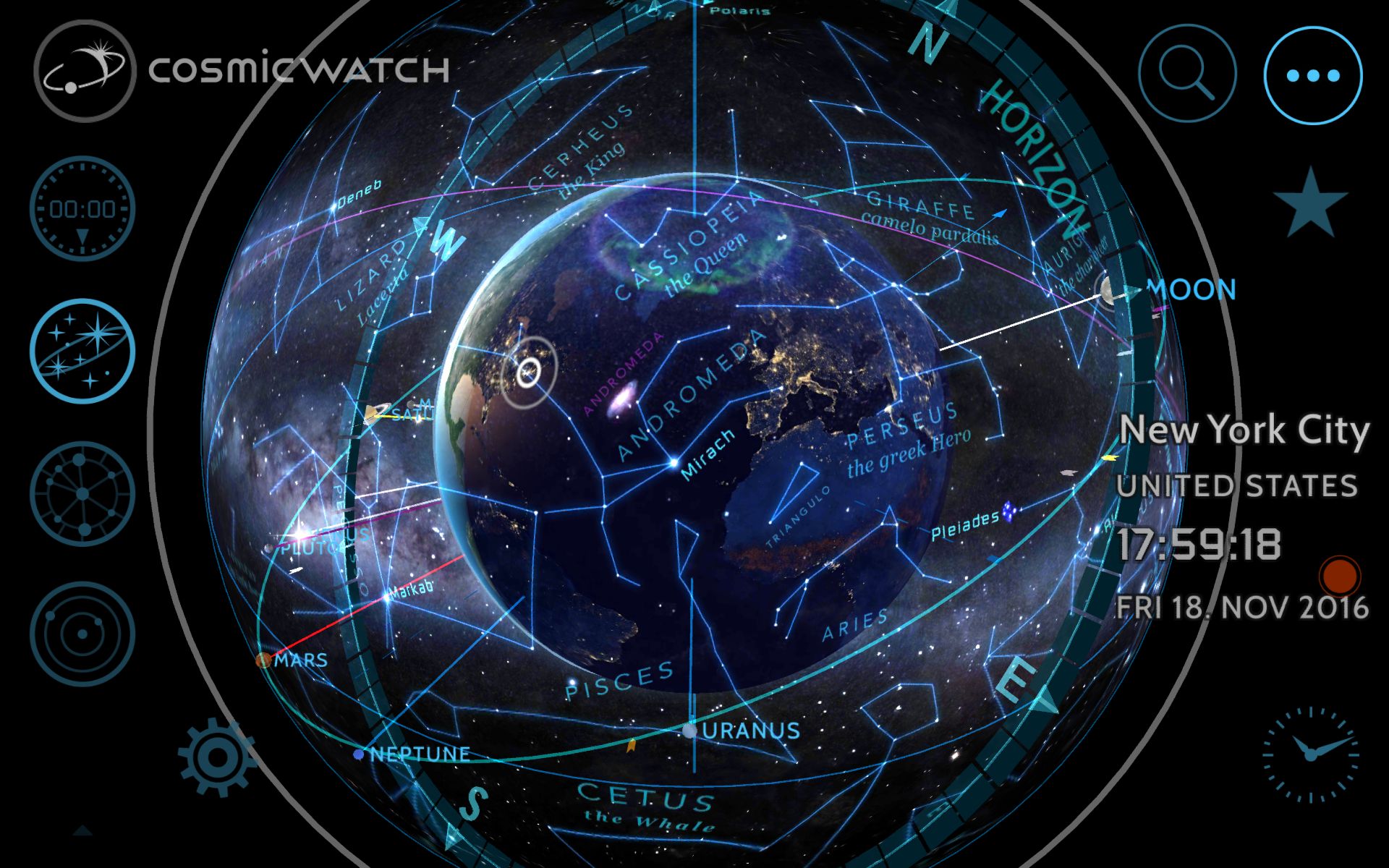
Our clocks and calendars originate from the regular and predictable motions of the Earth, moon and sun. The first handmade clocks were works of art displayed prominently in the homes of the wealthy. Their makers often incorporated motifs of the sun and moon, and their motions through the fixed stars of the zodiac, on their clock's faces.
Our seasons change due to the Earth's tilted axis of rotation and our orbit around the sun, concepts that are sometimes difficult to visualize. As early as the fourth century B.C., Chinese astronomers recreated those motions by constructing devices called armillary spheres. Over the centuries, they have been refined and enhanced, becoming impressive features of science museums, and reproduced as brass miniatures for household decoration.
The planets, too, move like clockwork through the sky. The ancient Greeks captured the celestial motions in the famous Antikythera Mechanism, discovered in a shipwreck in 1900 and dated between 150 and 100 B.C. Once clock-making technology became sufficiently advanced, planetary motions were reproduced with hand-cranked or clock-driven mechanical miniature solar systems called orreries. [Stunning NASA Video Shows 3 Years of the Sun in 3 Minutes]

The digital era has allowed all of the mathematics, geometry and beauty of these astronomical instruments to be reproduced on your favorite mobile device. In this edition of Mobile Stargazing, we'll take a look at the unique Cosmic Watch App for iOS and Android.
The Cosmic Watch App
Cosmic Watch is a terrific and visually stunning app that turns your device into a veritable Swiss army knife of astronomy, timekeeping and more. And I'm not kidding about the "Swiss" thing — the creative team is based in Switzerland. As with any fine timepiece, what's inside counts just as much — and the app's mathematical and geometric software make it an impressive tool.
When you launch the app, it uses your device's time and location to display a 3D globe of the Earth, centered on your location and beautifully rendered with a realistic sunlit hemisphere and NASA's Black Marble mosaic for the nighttime hemisphere. The sunrise and sunset boundaries flow across the Earth in real time, so you can see at a glance whether your family and friends in far-flung places are awake or asleep. The globe and the additional graphical elements can be rotated and zoomed in on with one- and two-finger gestures. As an astronomer, I particularly enjoyed exploring the distribution of light pollution on the nightside.
A tap anywhere on the globe displays the local time there. A search icon accesses a database of 15,000 cities and big towns. Up to three locations at a time can be saved as favorites, and the current favorite's name, time and date are displayed. A tap of the star icon at right calls up the favorites list and allows one-tap selection to return home or delete a favorite.
Get the Space.com Newsletter
Breaking space news, the latest updates on rocket launches, skywatching events and more!
The app focuses on four modes of operation — time and date, astronomy, astrology and a digital model of the solar system (an orrery). While most astronomers dismiss astrology as a means to predict your personality or the kind of day you'll have, there are elements of astronomy behind it. So it's interesting to compare that mode with the others. Depending on the operating mode, the Earth is surrounded by a variety of additional elements. A small display can get pretty cluttered, but nearly everything can be independently toggled on or off according to your preferences.
A clock icon at lower right enables the time and date control panel, where you can manually increment the year, month, day, hours, minutes and seconds. There is also a set of time-flow controls that allow time to be paused and flowed forward and backward. Multiple taps increase or decrease the rate. Users of the SkySafari 5 app will be familiar with the system.
A red circle icon, located near the city name, captures the current display with options to share the image on social media or save it to your device.
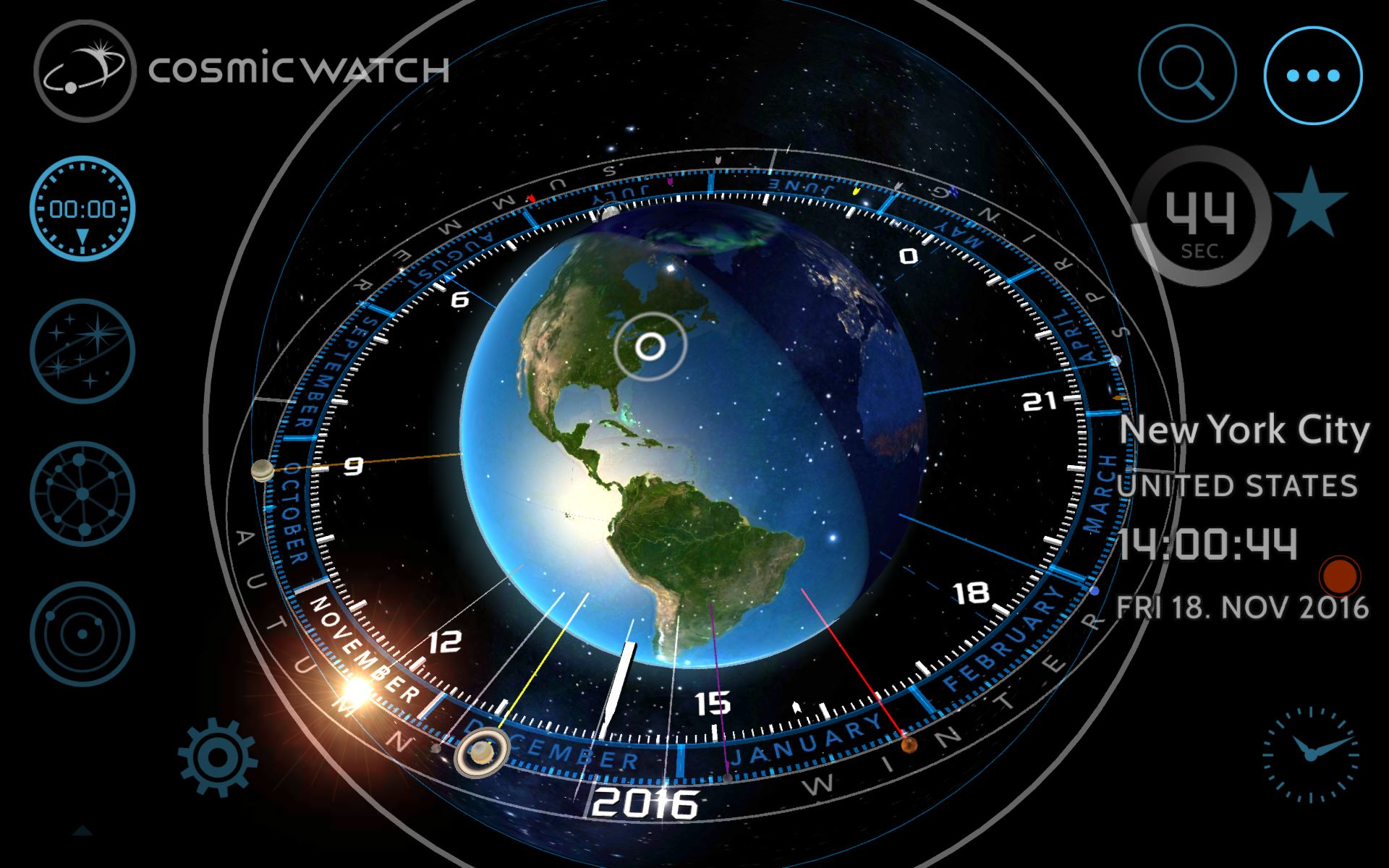
The operating modes
The app launches in clock mode, with the Earth surrounded by the sun, moon and planets displayed as miniature globes (not to scale) arranged at their current positions along a 3D ecliptic plane. A 24-hour clock dial follows the ecliptic. It's synchronized to the noon-time sun, and features a clock hand pointing to the current local time. The stars are subtly present in a celestial sphere around the Earth. A tap on the gear symbol at lower left reveals the settings menu icons; the clock submenu allows you to add a separate ring representing a calendar with the sun on the current date, and another ring for the seasons.
The user can tap an icon in the upper right to hide the control icons. The wealth of detailed 3D rendering in the app may give your device a bit of a workout — and for this reason, I don't see too many people using the Cosmic Watch as their primary clock app.
In astronomy mode things get more interesting. The celestial sphere is presented in a "God's Eye" view around the Earth, with the stars, constellation lines and Milky Way all projected onto a single celestial sphere. Constellation and bright star names are included, too. You can roll the sphere around and zoom in, but the constellations are viewed from "behind," so they'll be reversed from the real sky. The Sky settings menu lets users toggle the constellation stick figures and add photographic representations of the Milky Way in visible light and infrared. If you tap the icon to switch from Celestial Sphere to open sky, the sphere opens wider and you see it from within, similar to reality. Note that you'll need to rotate your location on the globe away from you to see the stars in your own sky, and that the Earth globe will always be hiding the center of the star field.
The planets are once again present in their proper sky positions, so you can determine which constellations to find them in. To help find the smaller planets, color-coded rods connect each planet with the Earth's center. They, and the planet names, are toggle items. The moon is displayed at its current phase; however, it's rendered from behind, therefore reversed from what would be seen on Earth. [Our Solar System: A Photo Tour of the Planets]
The Guides submenu offers some hidden gems. There's an equatorial coordinates grid. You can switch on the observer's horizon ring, complete with direction labels, and then enable your device's compass, which allows you to rotate your device to align the app with true north and then use it to see the direction of objects in the real sky. It won't help you with the objects' height above the horizon, but it'll get you most of the way there. Be careful that you don't accidentally change your viewing location by tapping on the globe. At present, there is no option to lock the selected city, but you can quickly restore home using the favorites icon.
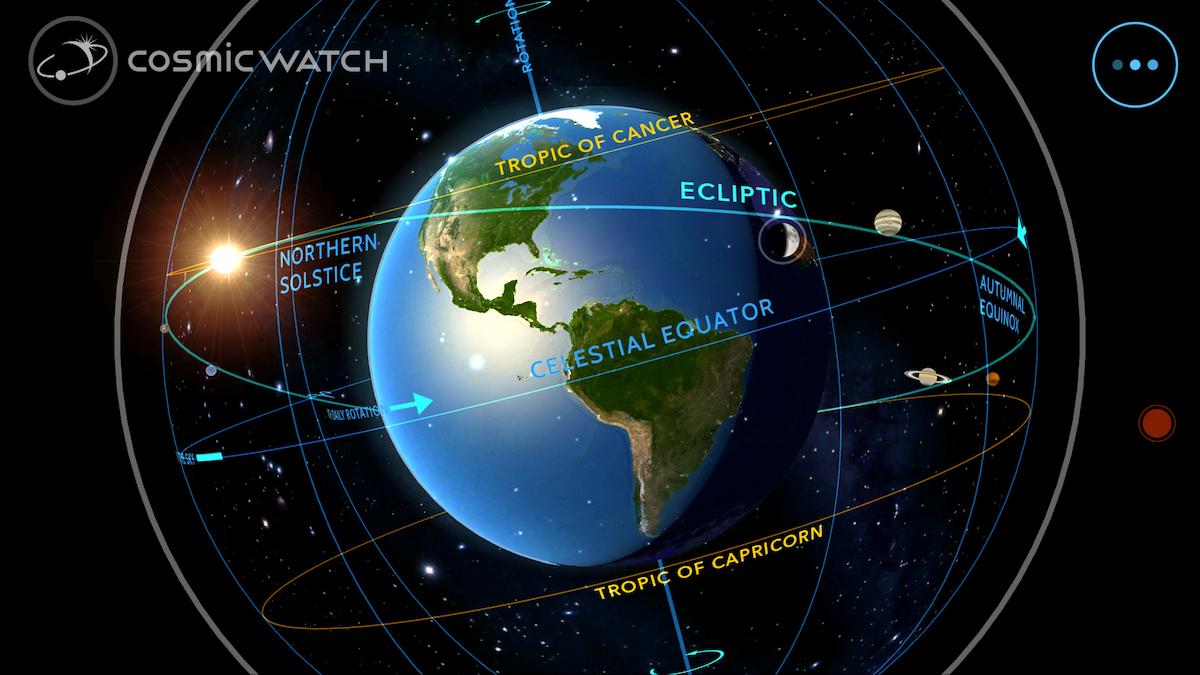
Switching on the Celestial Rings turns the app into a virtual armillary sphere. The Earth's axis of rotation and direction of motion are displayed, along with the equator and tropics rings. The equinox and solstice locations on the ecliptic are indicated. By setting the dates and times, the configuration of the Earth and sun at the onset of each season can be nicely demonstrated, and the time-flow controls can quickly run it through the entire year.
The digital orrery is fun to play with to see the current arrangement and the motions of the solar system bodies through time. In this mode, the shapes and inclinations of the orbits are shown to scale, but only the inner planets are displayed. When flowing time at a high rate, color-coded trails are left behind as the planets move, allowing you to see the complex dance of the objects over many years and their retrograde and prograde motions. At present, the display remains centered on the Earth, but there are future plans to offer a heliocentric option.
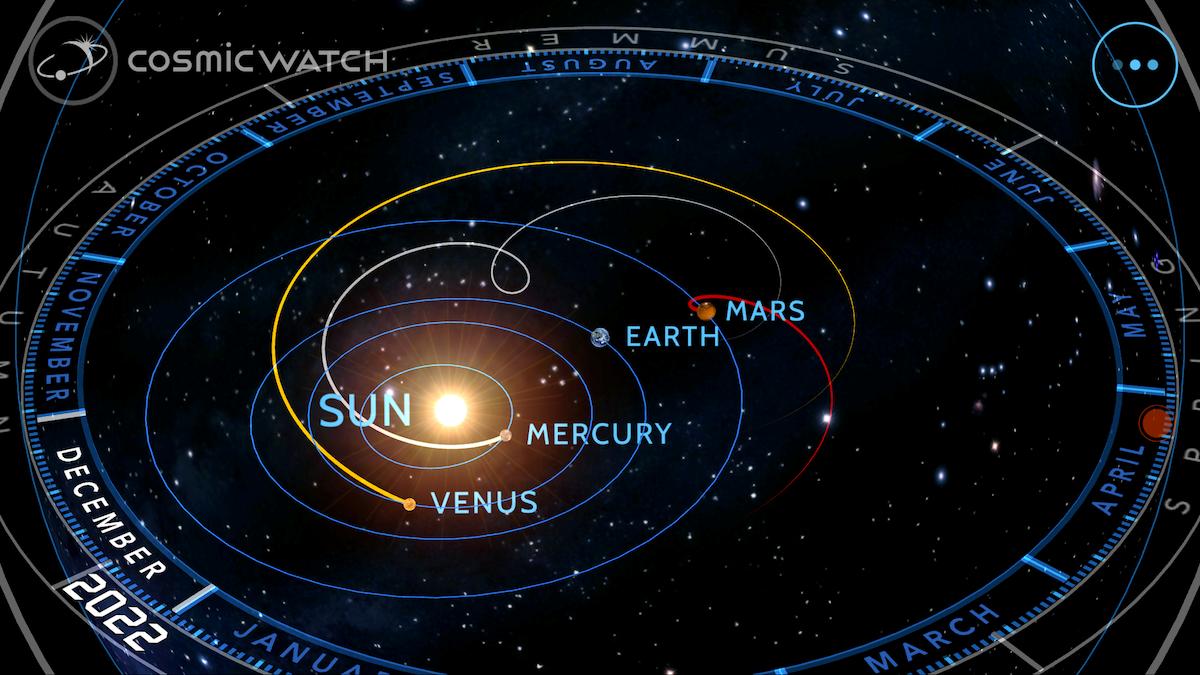
Some final thoughts
It's likely you'll find yourself captivated by the beauty of the app, spending lots of time playing with all the options while you roll the Earth and sky around, or just letting the time flow forward and watch everything move — I know I did. The Cosmic Watch app won't take the place of your favorite astronomy charting app because it doesn't really replicate the natural night sky from your location. But it offers many things traditional astronomy apps do not, particularly the ability to view the Earth and sun system from afar.
The app would benefit from a few additional features. Once started, the 3D-rendered display tends to continue to roll, as it would in frictionless space, and it can be tricky to orient the sphere at a particular attitude and keep it there. So an option to stop the rotation altogether, or lock one of the rotational directions, would be useful. It would also be nice to be able to search for celestial objects by name. As an astronomical clock, it would be nice to be alerted about astronomical events, such as the rising and setting of the sun, moon and planets. A plug-in showing the position of each major meteor shower's radiant over the Earth would be especially nice for planning meteor watching. I have been told that some of these things are in the works.
For any setup beyond the simple clock, the app is definitely better suited to a tablet screen. In fact, it is so detailed and beautiful that it would display nicely on a larger device, such as an HDTV. This would also be a good way to use it in the classroom. The number-crunching of the 3D rendering may also tax your device's battery.
The app's developers have an extensive website that includes instructional videos, some history of astronomical instrumentation, application ideas and more. And they welcome user feedback.
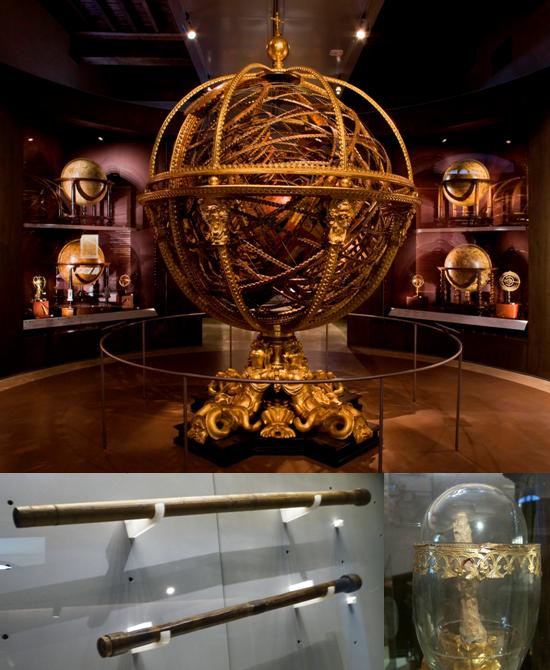
Going beyond
Anyone interested in classical clocks, armillary spheres, orreries and other astronomical devices should one day try to visit the Galileo Museum in Florence, Italy. The museum holds some of astronomy's most important artifacts, including astronomer Galileo Galilei's original telescope, and his mummified finger! There's also an extensive collection of fascinating Renaissance science and technology devices, a 62-inch (2.45 meter) diameter armillary sphere, classical celestial globes and much more. If you can't make it to Florence, download their free Museo Galileo app for iOS and Android. It features images, audio clips and written descriptions of many of the objects, and video clips describing many aspects of the era's science.
Future editions of mobile stargazing will feature some gadget reviews, measuring stellar distances and seeing constellations in 3D, and more. Until then, keep looking up!
Editor's note:Chris Vaughan is an astronomy public outreach and education specialist, and operator of the historic 1.88-meter David Dunlap Observatory telescope. You can reach him via email, and follow him on Twitter as @astrogeoguy, as well as on Facebook and Tumblr.
This article was provided by Simulation Curriculum, the leader in space science curriculum solutions and the makers of the SkySafari app for Android and iOS. Follow SkySafari on Twitter @SkySafariAstro. Follow us @Spacedotcom, Facebook and Google+. Original article on Space.com.
Join our Space Forums to keep talking space on the latest missions, night sky and more! And if you have a news tip, correction or comment, let us know at: community@space.com.
Chris Vaughan, aka @astrogeoguy, is an award-winning astronomer and Earth scientist with Astrogeo.ca, based near Toronto, Canada. He is a member of the Royal Astronomical Society of Canada and hosts their Insider's Guide to the Galaxy webcasts on YouTube. An avid visual astronomer, Chris operates the historic 74˝ telescope at the David Dunlap Observatory. He frequently organizes local star parties and solar astronomy sessions, and regularly delivers presentations about astronomy and Earth and planetary science, to students and the public in his Digital Starlab portable planetarium. His weekly Astronomy Skylights blog at www.AstroGeo.ca is enjoyed by readers worldwide. He is a regular contributor to SkyNews magazine, writes the monthly Night Sky Calendar for Space.com in cooperation with Simulation Curriculum, the creators of Starry Night and SkySafari, and content for several popular astronomy apps. His book "110 Things to See with a Telescope", was released in 2021.


